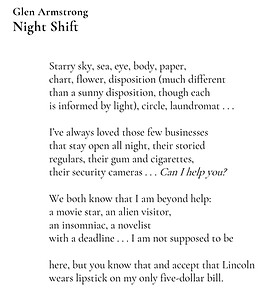
Anne Cheilek
Ghost Imprints
of an Ancient Form
The sonnet is over eight hundred years old, and yet it refuses to die. The 20th century was a hotbed of sonnet innovation, and the new millennium has already seen exciting new books of sonnets from such luminaries as Terrence Hayes and Diane Seuss. Of course, this venerable form has changed quite a bit over the years, shedding meter, rhyme, and other rules that once governed its structure. The typical modern sonnet retains just two of the traditional insignia: it’s fourteen lines long, and has a volta or turn near the end. But some sonnets toss even those rules. As the Academy of American Poets says, “today’s sonnet can often only be identified by the ghost imprint that haunts it.”
In this inaugural issue of Midnight Chem, we offer four examples of 21st century sonnets, each with a novel take on the form; each with a unique, half-mad ghost haunting its lines.
Timmy Chong’s sonnet “Sugarinabowl” is so tightly constructed that it appears to be typeset with full justification, like a newspaper column. But in fact, this effect is created by the poet’s precision engineering: Chong carefully manipulated the number of characters in each line so that they all appear to be of exactly equal length. This novel technique is a perceptive echo of our modern online lives, in which so many of our communications are measured out, not in coffee spoons, but in character-count limits set by corporate decree.
Maya Cheav’s poem “why I have been blacklisted from every strip club in the pacific northwest” breaks the traditional fourteen-line structure into three stanzas; the volta occurs in the last two lines, just as Shakespeare might have done it. But she adds a fresh feature to the beginning of her sonnet: in place of an epigraph, this poem includes a TL;DR (“Too Long; Didn’t Read”) summary for those modern readers who may find themselves in such a rush that fourteen lines seems dauntingly discursive.
“Night Shift” by Glen Armstrong seems, at first glance, to stick closely to the traditional form. Consisting of three quatrains plus a couplet, it bears a superficial resemblance to a Shakespearean sonnet. But Armstrong’s use of enjambment, caesura, ellipsis, and other modern techniques of fragmentation mark this as a very different animal.
Finally, Simone Zapata’s radically innovative poem “As Particulate Matter” explodes the body of the sonnet into individual atoms: each line resides within its own box, which may overlap or intersect with other line-boxes. Her poem can be read in many different orders, which means that the volta can occur almost anywhere.
Please enjoy this exploration of the (modern) ghosts in the (ancient) machine.




